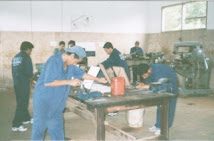Disusun Ulang Oleh:
Arip Nurahman
Pendidikan Fisika, FPMIPA Universitas Pendidikan Indonesia
&
Follower Open Course Ware at MIT-Harvard University, Cambridge. USA.
Nuclear reactor physics is the branch of science that deals with the study and application of chain reaction to induce controlled rate of fission for energy in reactors. Most nuclear reactors use a chain reaction to induce a controlled rate of nuclear fission in fissile material, releasing both energy and free neutrons. A reactor consists of an assembly of nuclear fuel (areactor core), usually surrounded by a neutron moderator such as regular water, heavy water, graphite, or zirconium hydride, and fitted with mechanisms such as control rods that control the rate of the reaction.
Lecture Notes
| LEC # | TOPICS | |
|---|---|---|
| 1 | Basic Nuclear Concepts (PDF) Supplement (PDF) | |
| Quantum Mechanical Description of Nuclei | ||
| 2 | Schrödinger Wave Equation (PDF) | |
| 3 | Bound States in One Dimensional Systems – Particle in a Square Well (PDF) | |
| 4 | Bound States in Three Dimensions -- Orbital Angular Momentum (PDF) | |
| 5 | Barrier Penetration (PDF) | |
| 6 | The Neutron-Proton System: Bound State of the Deuteron (PDF) | |
| 7 | Overview of Cross Section Calculation (PDF) | |
| 8 | Neutron-Proton Scattering (PDF) | |
| 9 | Quiz 1 Review | |
| Quiz 1 (Lec #1-8, Closed Book) | ||
| Nuclear Binding, Stability and Decay | ||
| 10 | Nuclear Shell Model (PDF) | |
| 11 | Nuclear Binding Energy and Stability (PDF) | |
| 12 | Binding Energy and Mass Parabolas (PDF) | |
| Interaction of Radiation with Matter | ||
| 13 | Radioactive-Series Decay (PDF) | |
| 14 | Charged Particle Interactions: Stopping Power, Collision and Ionization (PDF) | |
| 15 | Charged Particle Interactions: Radiation Loss, Range (PDF) | |
| 16 | Neutron Interactions: Q-equation and Elastic Scattering (PDF) | |
| 17 | Quiz 2 Review | |
| Quiz 2 (Lec #9-15, Closed Book) | ||
| 18 | Neutron Interactions: Energy, Angular Distributions, Thermal Motions (PDF) | |
| 19 | Gamma Interactions: Compton Scattering (PDF) | |
| 20 | Gamma Interactions: Photoelectric Effect and Pair Production (PDF) | |
| 21 | Detection of Nuclear Radiation: Pulse Height Spectra (PDF) | |
| Nuclear Processes | ||
| 22 | Nuclear Decays (PDF) | |
| 23 | Nuclear Reactions: Energetics and Compound Nucleus (PDF) | |
| 24 | Quiz 3 Review | |
| Quiz 3 (Lec #16-21, Closed Book) | ||










Tidak ada komentar:
Posting Komentar